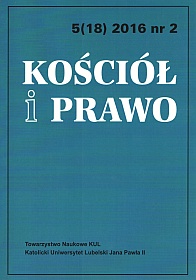The Right to Manifest Religious Beliefs through Religious Symbols in the Light of the Judgment Eweida and Others v. the United Kingdom from January 15, 2013
Abstract
The article examines issues related to the right to manifest religious beliefs on the basis of existing European legislation, which is expressed especially in jurisprudence of the European Court of Human Rights. In particular, it highlighted the very important role of giving the answer to the question whether the behavior is a manifestation of religious beliefs, or is it only inspired by them or is only a matter of personal choice. As an example of the difficulties in answering this question, there was invoked the judgment of the European Court of Human Rights in case Eweida and others against the United Kingdom, where this issue has occupied an important place. The Court considered wearing a cross by N. Eweida and S. Chaplin as a form of manifestation of their faith. The Court rejected the position of the British courts, which reduced cross for jewelry, and his wearing considered as a personal choice of the applicants.
References
Ahdar, Lex, and Ian Leigh. 2013. Religious Freedom in the Liberal State. Oxford: Oxford University Press.
Cohen, Gideon. 2010. “Article 9 of the European Convention of the Human Rights and Protected Goods.” Ecclesiastical Law Journal 12:180-201.
Emmerson, Ben, Andrew Ashworth, and Alison Macdonald, eds. 2012. Human Rights and Criminal Justice. London: Sweet & Maxwell.
Equality and Human Rights Commission. 2012. Human Rights Review 2012. How fair is Britain? An assessment of how well public authorities protect human rights. London: EHRC.
Evans, Carolyn. 2012. Freedom of religion under the European Convention on Human Rights. New York: Oxford University Press.
Falski, Jacek. 2011. „Wokół zakazu symboli religijnych we francuskiej szkole publicznej.” Państwo i Prawo 12:43-55.
Garlicki, Leszek. 2010. „Art. 9 [Wolność myśli, sumienia i wyznania].” W Konwencja o Ochronie Praw Człowieka i Podstawowych Wolności. T. 1, Komentarz do artykułów 1-18, red. Leszek Garlicki, 550-83. Warszawa: Wydawnictwo C.H. Beck.
Hatzis, Nicholas. 2011. “Personal Religious Beliefs in the Workplace: How Not to Define Indirect Discrimination.” The Modern Law Review 74:287-305.
Hill, Mark. 2013. “Lillian Ladele is the real loser in Christian discrimination rulings.” The Guardian, January 17. Accessed April 30, 2016. http://www. theguardian.com/commentisfree/belief/2013/jan/17/lillian-ladele-loser-christian-discrimination-rulings
Hill, Mark. 2013. “Religious Symbolism and Conscientious Objection in the Workplace: An Evaluation of Strasbourg’s Judgment in Eweida and Others v United Kingdom.” Ecclesiastical Law Journal 15:191-203.
Hucał, Michał. 2012. Wolność sumienia i wyznania w orzecznictwie Europejskiego Trybunału Praw Człowieka. Warszawa: Wydawnictwo C.H. Beck.
Kącka, Katarzyna. 2013. „Geneza i źródła wolności religii w europejskiej przestrzeni politycznej i prawnej”. Seminare 34:155-74.
Krukowski, Józef. 2013. Kościelne prawo publiczne. Prawo konkordatowe. Lublin: Towarzystwo Naukowe KUL.
Kuriata, Agnieszka. 2015. „Strój muzułmanek we Francji a wpływ islamu.” Acta Erasmiana VIII. Wiara, polityka i religia 8:119-34.
Lord Carey of Clifton, Michael Scott-Joynt, Michael Nazir-Ali, Peter Forster, Anthony Priddis, and Nicholas Reade. 2010. “The religious rights of Christians are treated with disrespect.” The Sunday Telegraph, March 28. Accessed April 14, 2016. http://www.telegraph.co.uk/comment/letters/7528487/The-religious-rights-of-Christians-are-treated-with-disrespect.html [dostęp: 14.04.2016].
Mazurek, Franciszek Janusz. 1998. „Prawo człowieka do wolności religijnej.” Kościół i Prawo 5:95-102.
McCrea, Ronan. 2014. “Religion in the Workplace: Eweida and Others v United Kingdom.” The Modern Law Review 77:277-307.
Misztal, Henryk, i Piotr Stanisz. 2010. „Wolność wyznania a symbole religijne w życiu publicznym państwa świeckiego.” Annales Canonici 6:37-55.
Orzeszyna, Krzysztof. 2007. Podstawy relacji między państwem a kościołami w konstytucjach państw członkowskich i traktatach Unii Europejskiej. Lublin: Wydawnictwo KUL.
Rozner, Monika. 2002. „Prawo do wolności religijnej w Europejskiej Konwencji Praw Człowieka z 1950 r.” Studia z Prawa Wyznaniowego 5:111-39.
Sobczak, Jacek, i Maria Gołda-Sobczak. „Wolność sumienia i wyznania jako prawo człowieka.” Annales UMCS. Sectio K. Politologia 19:28-65.
Szczech, Tomasz. 2011. „Czy wolność religijna jest wolnością od religii? Sprawa Lautsi przeciwko Włochom a kryzys wolności religijnej w Europie.” W Religia a prawo i państwo, red. Mirosław Sadowski, i Piotr Szymaniec, 385-413. Wrocław: Beta-Druk.
Taylor, Paul. 2005. Freedom of Religion: UN and European Human Rights Law and Practice. Cambridge: Cambridge University Press.
Vickers, Lucy. 2014. “Religious Freedom: Expressing Religion, Attire and Public Spaces.” Journal of Law and Policy 22:591-611.
Vogel, Bernhard. 2007. „Unia Europejska a pluralizm religijny.” W Kultura i Prawo. Materiały V Międzynarodowej Konferencji na temat Tożsamość kulturowa Unii Europejskiej a pluralizm religijny. Trewir, 18-19 września 2006 r., red. Józef Krukowski, Josef Isensee, i Mirosław Sitarz, 25-37. Lublin: Towarzystwo Naukowe KUL.
Warchałowski, Krzysztof. 2004. „Ochrona prawa do wolności religijnej w prawie traktatowym Unii Europejskiej.” Studia z Prawa Wyznaniowego 7:5-18.
Copyright (c) 2016 Kościół i Prawo

This work is licensed under a Creative Commons Attribution-NonCommercial-NoDerivatives 4.0 International License.





